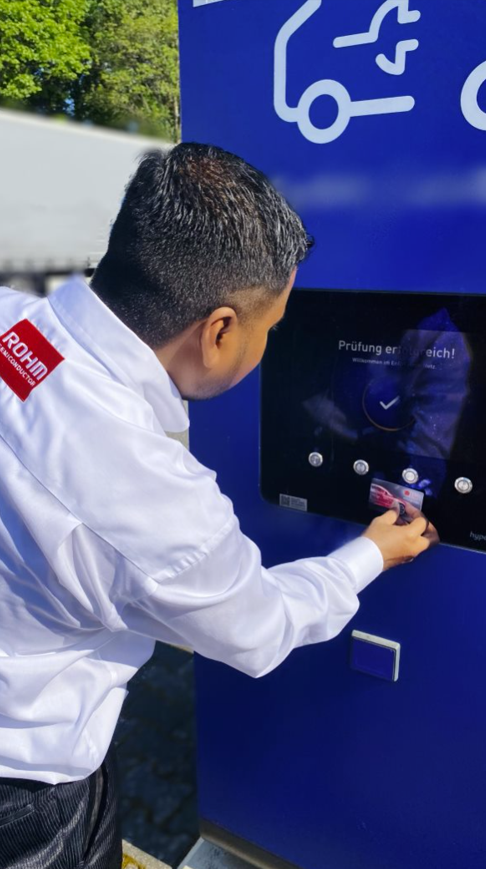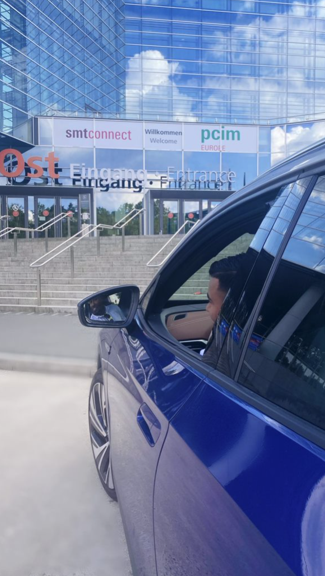1,000 kilometers by e-car: A long-distance trip with smart strategies
08/08/2022
Our colleagues Nelli Nising and Rony Karim recently went by e-car 1,000 km from “Rheinland” to “Franken” area and back to visit one of our industry fairs. For both, it was their first long-distance trip with a fully electric car – and therefore a very advantageous one. Now, they reveal their insights about the journey:
When Nelli Nising, Digital Marketing Manager at ROHM Semiconductor Europe, was asked if she wanted to go to PCIM, the leading power fair of the electronics industry, by e-car she didn’t hesitate long. “This way of mobility fits to my lifestyle very well as I like to travel ecologically friendly to preserve the environment.”

Ready for their adventure trip: Nelli Nising and Rony Karim.
Shortly after, she set off, together with her colleague Rony Karim, Application Marketing Manager at ROHM Semiconductor Europe. Rony drives an electric company car since April 2022. It is equipped with a 77kW battery and can drive up to 520 km by one charging. “Next to economic benefits, I like the thought to reduce my carbon footprint by driving an e-car,” says Rony.

Rony enjoys the drive with his new e-car.
For Rony the 1,000 km drive to Nuremberg and back was the first long distance trip with his new fully electric car.
But this didn’t make him nervous: “Before we left, I fully charged the vehicle via my wallbox at home. Also, while planning the drive, I made sure that a lot of charging stations are available on the route,” Rony recaptures.

Before the trip, Rony charged his car at home via his wallbox.
In fact, the two colleagues were not disappointed by the highway’s e-infrastructure and availabilities: “I was very surprised that so many charging stations were installed along the highway, even at small service stations. We didn’t even have to queue as not many people charged their cars,” Nelli recaptures.
In the event that there is not any charging option available on the way, Rony always has a portable charger with him to load the car battery. "This way we were equipped for all eventualities during our trip,” adds Rony.
Charging “on the fly”
Moreover, the charging process itself turned out to be simple: “ROHM has provided me with a charging card that can be used just as simple as a credit card.”

Easy handling via charging card.
The e-car and the card are connected to an app on Rony’s mobile phone. “My app tells me when the charging is finalized. Therefore, I don’t need to stand next to my car during the charging process but can have a coffee or check my e-mails instead. That’s very convenient,” states Rony. The display in Rony’s car gives him an exact overview of when he needs to charge.

Ready for charging? The car display provides Rony and Nelli with an exact battery capacity overview.
In total, it took about 25 minutes to recharge the car battery from 25% to 80% with an ultra fast DC (direct current) charging station.

By keeping an eye on the battery status, Rony can determine the best time for charging.
In fact, the point of charging time can determine loading times. “In general, the charging speed goes slower when the battery is already loaded at a higher percentage,” explains Rony. “For example, a 30 % loaded battery can be charged with 115kW. In contrast, an 80 % loaded battery can be charged only with a speed of 80 kW.
Surprising benefits of a traffic jam & gaining range
On top, Nelli and Rony realized that they can prolong the distances between charging times by applying a particular way of driving: “Each time we had to brake, for example during a traffic jam, the battery regained energy. Through this so-called recuperation process we were able to exceed our range. With a classic combustion car it is the different way around: Frequent start and stopping leads to higher gas consumption and therefore less range.”
Another strategy to gain range via e-car is through selecting the right driving style mode, Rony explains: “By choosing eco mode, you cannot go faster than 130 km/h. This selection extends range – especially when the battery is very low. In contrast, the sport mode, for example, loses power quickly as the e-car loses much power at a short time while kickstarting from 0 to 100 km.”

After 500 km, Nelli and Rony safely arrived in Nuremberg.
Rony already looks forward to next (business) trips with his e-car. “For the future, I expect the capacity of batteries to further extend and more people will be encouraged to choose an e-car,” he concludes.
